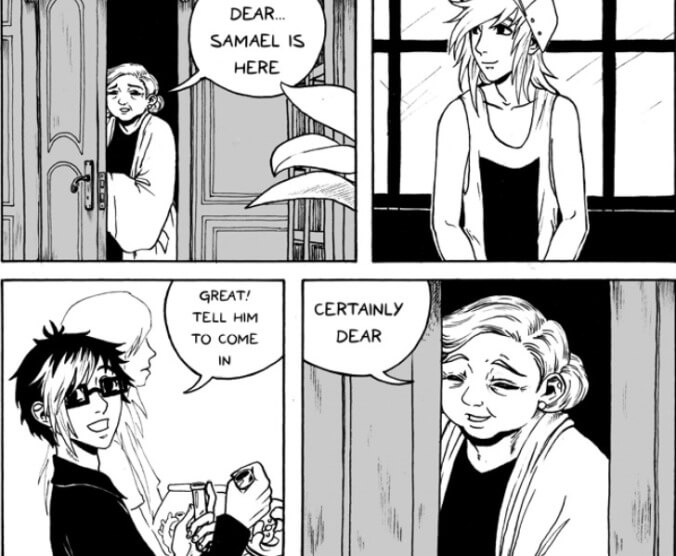In Anglophone circles, the Finnish comics artist and illustrator Broci is probably best known for their haunting prints that tackle all manner of spooky things, ranging from ghosts to eerie fairies to creatures from Finnish folklore. Their work as an illustrator of books will likely be more familiar to Finnish readers—though the general mood of that work can best be described as spooky, too. In fact, with incredibly rare exceptions, all of Broci’s work fits under the banner of horror, often exploring its intersections with other genres. Readers of their webcomic, Bad Friday, started in 2014 and consistently updated, will be familiar with their particular approach to horror.
The webcomic is an intimate and loosely interconnected anthology, centered around a group of friends, wherein Broci explores various horror tropes and the way they manifest through interconnected genres. Many of the updates include quotations from work that either influenced or has parallels with whatever story arc is being depicted. The types of horror the webcomic addresses range from Lovecraftian entities to zombies, with many arcs ending on cliffhangers—not to be tackled later, but to leave the reader with the overall impression that horror is always lurking just around the corner in Bad Friday.
And horror is always lurking there. Sharp-eyed readers will pick up on Broci’s frequent use of isometric panels, especially in rendering settings: Other than how these panels establish the setting in the reader’s mind, this approach allows Broci to hide glimpses of horror—such as a lingering ghost—in background details, to startling effect.
There is a clear manga influence in Broci’s hand-drawn and digitally altered pages. Some panels feature halftone dotted backgrounds common to the genre, as are the frequent focus lines and gradient backgrounds. The most overt influence (not just on Bad Friday, but most of Broci’s work) is the work of the manga group CLAMP, famous for Cardcaptor Sakura and xxxholic. Broci’s character designs hearken back to CLAMP work, though their ethereal artwork showcases a unique fashion sense (likely developed through their degree in Fashion and Clothing design). The manga technique of particular interest here is Broci’s tendency to use superdeformation: Characters will go chibi at times (a specific style of caricature where characters are drawn in an exaggerated way) but then the next panel will be rendered in extreme detail. This, perhaps, ties into the comic’s larger rhythm where goofy moments between friends are followed by pure horror—to jarring, destabilizing effect.
As Webtoon’s webcomics become more and more industrialized, it’s important to note how their self-propelled nature allows artists time to experiment and develop a style at their own pace. The early work of Bad Friday available now is not the same as what was published in 2014; Broci began redrawing some pages in 2018. While this development in their style might be attributed to the professional work they’ve consistently done alongside Bad Friday, it’s likely that some of it can be chalked up to the experimentation we see them engage with in the webcomic. Take, for example, the inclusion of a black and white pattern breaking red wash over panels depicting an alien interaction, representing a diegetic light. On one page, Broci combines the gradient of their general manga-inspired style with red light.
This level of experimentation, coupled with the general spooky vibe inherent to Broci’s art, is a big part of why it’s such a triumph—and why the intimacy of webcomics like Bad Friday deserve to be celebrated.









































